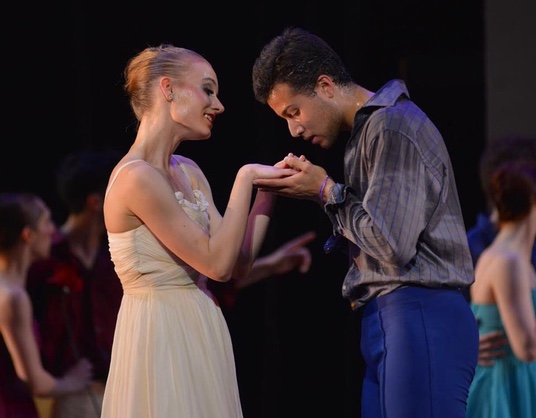Fri 5/13-Sat 5/14
You needn’t be a dance history geek to know that dancing automatons — or dancers imitating automatons – were a frequent theme in 19th-century ballets. Just think of Coppélia or Nutcracker, both of whose title characters were animated dolls. But today the uncanny valley is more a problem to be overcome rather than an object of fascination. Which is why, we suppose, Cleveland Ballet’s production of Coppélia emphasized the love story.
It’s a love story that does not proceed smoothly. Very early in the first act of this Coppélia, we see Swanilda and her girlfriends dancing, but they are upstaged by Franz’ friends trying to get the attention of the mysterious girl — the mechanical doll — in the upstage window. And that’s the conflict and the premise of this ballet right there in a nutshell. Swanilda wants Franz to marry her and Franz is willing, but his roving eye keeps turning to the mechanical doll in the window which puts Swanilda off Franz and the marriage. What to do?
Fortunately, dear reader, Dr. Coppélius leaves his house and, when accosted by the rowdy boys, drops his house key. Swanilda finds the key and leads her friends inside. Meanwhile, the determined Franz uses a ladder to get inside and Dr. Coppélius returns home to find his front door wide open! Everyone is inside the house of the mysterious Dr. C! End of the first act. Consider the plot thickened.
Walking around during intermission, enjoying the Ohio Theatre’s beautifully restored (original) lobby, we had abundant opportunity to savor the beautiful score by Léo Delibes. Balanchine opined, “Ballet music in Coppélia participates in the dance drama as never before.” Indeed, the music seems to us to move the story along and tell us what the characters are feeling but at the same time, there’s really no authoritative version of Coppélia. So the choreographer, in this case Ramón Oller, has considerable freedom to interpret each musical number as he chooses.
In the prelude to the first act, for instance, when we see Oller dancing with Elena Cvetkovich as Dr. Coppélius and Coppélia, it’s not the usual scene of man and machine, for Cvetkovich dances with considerable fluidity. Instead we are shown Dr. Coppélius exerting his will to animate and control Coppélia, an illusion that both dancers must contribute to.
When Nicholas Montero as Franz dances his first solo early in the first act, we see that he’s an accomplished young ballet technician who shows nice lines, strongly pointed feet and a secure finish for each step. And, as the story continues, Montero proves good at portraying the rash, impulsive Franz.
Lauren Stenroos as Swanilda unfortunately makes a less favorable impression in her first solo, struggling to complete doubles on some of her traveling turns and looking less than perfectly secure on her points as a result. Fortunately, she redeems herself as the story continues, finding a level of execution appropriate to Swanilda’s take-charge personality.
Stenroos’ partnering with Montero — always a team effort — is particularly successful toward the end of the first act. Her high extensions correspond nicely with the singing clarinet in the Delibes score; their powerhouse pas de deux concludes with an exotic, behind-the-back fish dive. But just as we were saying to ourselves, “Oh, my! How’d they do that?,” Montero’s Franz is again distracted by the Coppélia doll, Swanilda sees, and he’s in the doghouse again.
Stenroos and Montero are only one of five couples dancing together toward the end of the first act, which argues for unusually good partnering skills in this company. Time for us to sing the praises of Swanilda’s maid of honor, Lüna Sayag, and three friends, Emily Fennell, Theresa Holland and Kathryn Tokar.
Like most productions of Coppélia, this Cleveland Ballet production recasts many of the dancers from the first act as dancing dolls in the second act. Tall, amiable Jason L. Wang, who smoothly mimed Swanilda’s father in the first act, portrays the Sultan Doll in the second. Franz’ best man, Victor Jarvis, and three friends, Addison Goodwin, Jonathan Leonard and Luke Potgieter, all put aside the youthful machismo (and good partnering skills) of their first act characters to become dancing mechanical dolls.
The second act in Dr. Coppélius’ workshop is usually Swanilda’s chance to shine, and so it is in this production, for Franz is overcome by Dr. Coppélius’ magic and forced to drink himself unconscious. So it’s up to quick-thinking Swanilda to save him by impersonating the doll Coppélia. Oller gives his Dr. Coppélius and Stenroos’ Swanilda a comic interaction that combines mime and partnering as he puzzles over apparent glitches in the interface between his will and the supposed doll’s behavior.
Yes, dear reader, she married him. By the time Swanilda and Franz are married and the curtain comes down, the entire 14- person company has a lot to be proud of. They’re a nice-looking group of young dancers and we hope they’ll stick around for a while so that we can see them grow together in future productions here.
The 24 guests, students from the School of Cleveland Ballet, looked excited, happy and well-rehearsed. We wish they could have been given more to do, but even a brief appearance onstage is important for students and apprentices.
Ramón Oller’s reputation as a choreographer of dark, intense contemporary dances preceded him so we were pleasantly surprised at how successfully he gave himself over to this comic ballet. More please, from this talented and versatile dancer / choreographer.
Meanwhile, the story of Cleveland Ballet continues. The School of Cleveland Ballet has a recital coming up Sat 5/21. The company plans to participate in PlayhouseSquare’s Dance Showcase on Fri 9/9, an opportunity to see them and other companies free. Go to ClevelandBallet.org to learn about much more to come.
[Written by Elsa Johnson and Victor Lucas]
